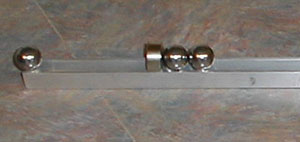Attraction. Collision.

Magnetic Accelerator, steel ball bearings and magnets. (Click
on the image to enlarge.)
Attraction. Collision.

Magnetic Accelerator, steel ball bearings and magnets. (Click
on the image to enlarge.)
Introduction
Magnets and ball bearings can be arranged so that a steel ball bearing is launched at high velocity.
Material
Assembly
File off both inside edges of the groove 15 cm from one end of the channel for the first stage. Make a 45 degree cut. The resulting edge will hold the magnet in place. Each additional stage should be filed 15 cm further along the groove.

Place a neodymium magnet into the groove, place two ball bearings on the downstream side of the magnet.
To Do and Notice.
Release a ball bearing at the end of the aluminum channel so that it is attracted to the magnet.
Notice that the most distant ball bearing on the far side of the magnet pops off with a high velocity.
Notice that the velocity of the ball bearings increases after each stage of amplification.
Notice that the last ball bearing is given a high velocity and can travel a long distance.
What's Going On?
The ball bearing is attracted to the magnet with a force that grows rapidly as the ball approaches the magnet. The ball collides with the magnet. The sound wave from the collision passes through the magnet and eventually reaches the most distant ball knocking it free. The most distant ball is far from the magnet and is weakly attracted to it. So that when it departs at a high velocity it is slowed very little by the attraction from the magnet. thus there is a velocity gain at each stage of the system.
Conservation of energy. Notice that when you reset the system for the next run you have to do a lot of work to remove one ball from each magnet. This work provides the energy which will be released during each collision.
|
Scientific Explorations with Paul Doherty |
|
8 July 2003 |